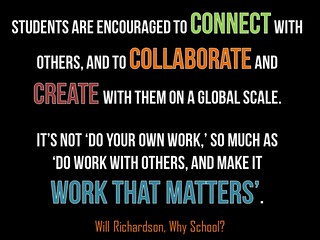One of the questions that I'm asked time and time again is, "How can teachers use technology to motivate our students?"
And if you've spent any time reading Radical posts, you probably know my answer already: Technology DOESN'T motivate students. Making a difference in the world does.
Technology just enables students to tackle the kinds of meaningful issues that once would have been out of their reach.

Need proof?
Look no further than the most successful project that I've ever pulled off - a microlending effort designed to give the twelve year old kids in my classroom the chance to lift people out of poverty.
What my students loved the best about our microlending project was the tangible sense of doing something bigger than themselves.
They totally DUG the notion that a bunch of tweens from Raleigh were helping REAL people in REAL countries that they'd never heard of solve REAL problems.
What I loved the best about our microlending project was that it allowed students to wrestle with several key elements of our required curriculum.
EVERYTHING that we did -- from researching potential loans to creating persuasive videos using Creative Commons images -- supported skills that my students had to learn in their language arts and social studies classes anyway.
Now that I'm teaching science, though, I've had to find another cause to rally my kids behind -- and I think I've finally found it.
Earlier this year -- as a part of work that we were doing with the new nonfiction reading standards in the Common Core State Standards -- we read this bit about New York City's decision to ban the sale of sugary drinks in containers larger than 16 ounces.
My kids were challenged by the article primarily because it forced them to wrestle with whether or not a government should have the right to control the foods that people put into their bodies -- even if those foods DO lead to a ridiculously high rate of obesity related diseases.
Turns out middle schoolers don't like being told what to do.
#shocker
Since then, we've done a bunch of work studying the soda ban -- including curating a public collection of resources about the issue that highlight both sides of the story.
To push the conversation further, we decided to create a blog that's designed to raise awareness about the amount of sugar in the foods that tweens and teens typically eat.
Check it out here:
In just two short weeks, I can already see the same electricity that defined my Kiva project returning to my classroom.
Every day, different kids come to school with new foods that they want to write about and new graphics that they want to create. We've done more talking about labels and healthy foods in five days than I've ever done with a group of kids in twenty years of teaching.
And even though contributions to our blog are completely optional and completely ungraded, I've got a room full of students in my room at lunch time every single day working on new posts.
Instructionally, they are getting a sense for what "healthy eating choices" look like in action and they are learning about voice and tone and writing for individual audiences.
They are also learning about the role that graphics can play in changing minds, learning about convincing statistics and reliable sources, and learning that learning can ACTUALLY be fun.
The lesson in our #sugarkills project is a simple one, y'all: Today's students don't care about technology. They care about making contributions.
My kids aren't motivated by the bells and whistles that come along with our new blog.
They're motivated by the notion that THEIR efforts -- THEIR decision to use THEIR voice to raise awareness about the sugars in foods -- might just keep other kids from making choices that carry a lifetime's worth of unhealthy consequences.
Do YOU want a highly engaged classroom? Do YOU want kids who are willing to write and to create and to publish and to think and to grow even if there's NOT a grade attached to the task?
Then start using digital tools to give your kids chances to be something more than they ever thought they could be.
You need to be a member of School Leadership 2.0 to add comments!
Join School Leadership 2.0